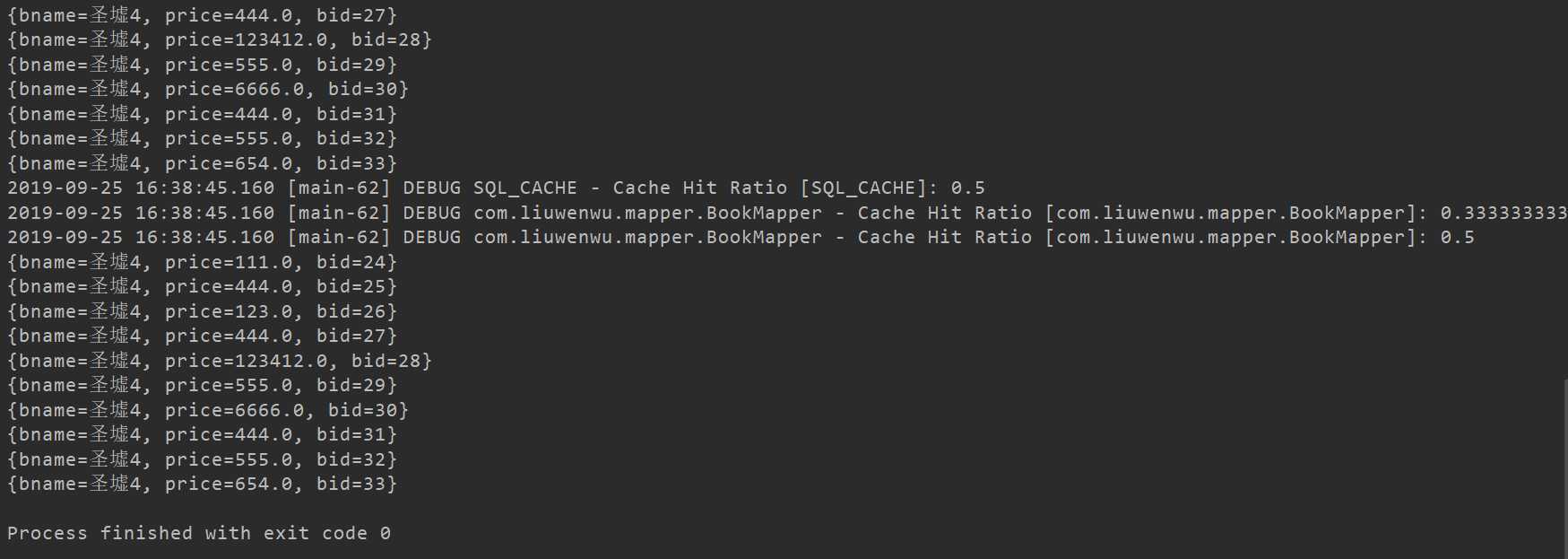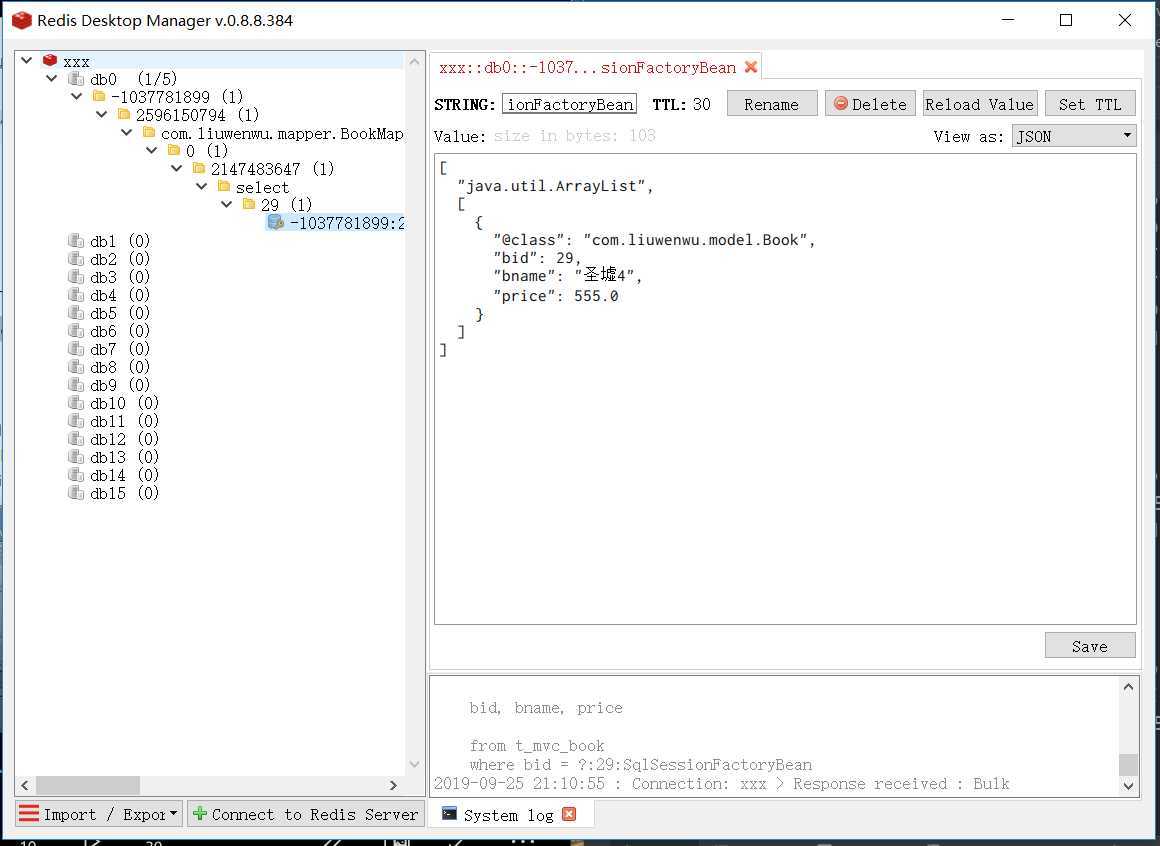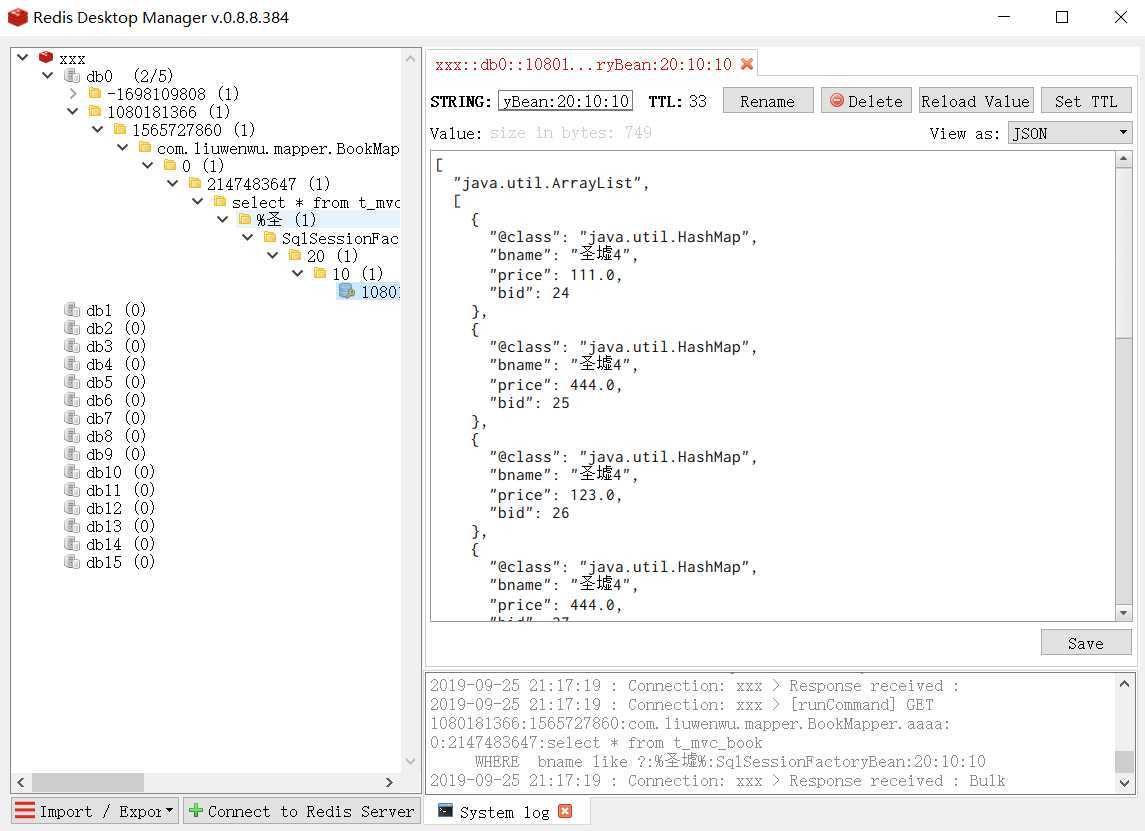标签:stp syn live ignore class user 结果 后台 ack
导入相关依赖
<dependency>
<groupId>org.springframework</groupId>
<artifactId>spring-context-support</artifactId>
<version>${spring.version}</version>
</dependency>
<!--mybatis与ehcache整合-->
<dependency>
<groupId>org.mybatis.caches</groupId>
<artifactId>mybatis-ehcache</artifactId>
<version>1.1.0</version>
</dependency>
<!--ehcache依赖-->
<dependency>
<groupId>net.sf.ehcache</groupId>
<artifactId>ehcache</artifactId>
<version>2.10.0</version>
</dependency>
修改日志配置,因为ehcache使用了Slf4j作为日志输出
日志我们使用slf4j,并用log4j来实现。SLF4J不同于其他日志类库,与其它有很大的不同。
SLF4J(Simple logging Facade for Java)不是一个真正的日志实现,而是一个抽象层( abstraction layer),
它允许你在后台使用任意一个日志类库。
<!-- log4j2日志配置相关依赖 -->
<log4j2.version>2.9.1</log4j2.version>
<log4j2.disruptor.version>3.2.0</log4j2.disruptor.version>
<slf4j.version>1.7.13</slf4j.version>
<!-- log4j2日志相关依赖 -->
<!-- log配置:Log4j2 + Slf4j -->
<!-- slf4j核心包-->
<dependency>
<groupId>org.slf4j</groupId>
<artifactId>slf4j-api</artifactId>
<version>${slf4j.version}</version>
</dependency>
<dependency>
<groupId>org.slf4j</groupId>
<artifactId>jcl-over-slf4j</artifactId>
<version>${slf4j.version}</version>
<scope>runtime</scope>
</dependency>
<!--核心log4j2jar包-->
<dependency>
<groupId>org.apache.logging.log4j</groupId>
<artifactId>log4j-api</artifactId>
<version>${log4j2.version}</version>
</dependency>
<dependency>
<groupId>org.apache.logging.log4j</groupId>
<artifactId>log4j-core</artifactId>
<version>${log4j2.version}</version>
</dependency>
<!--用于与slf4j保持桥接-->
<dependency>
<groupId>org.apache.logging.log4j</groupId>
<artifactId>log4j-slf4j-impl</artifactId>
<version>${log4j2.version}</version>
</dependency>
<!--web工程需要包含log4j-web,非web工程不需要-->
<dependency>
<groupId>org.apache.logging.log4j</groupId>
<artifactId>log4j-web</artifactId>
<version>${log4j2.version}</version>
<scope>runtime</scope>
</dependency>
<!--需要使用log4j2的AsyncLogger需要包含disruptor-->
<dependency>
<groupId>com.lmax</groupId>
<artifactId>disruptor</artifactId>
<version>${log4j2.disruptor.version}</version>
</dependency>
在Resource中添加一个ehcache.xml的配置文件
<?xml version="1.0" encoding="UTF-8"?> <ehcache xmlns:xsi="http://www.w3.org/2001/XMLSchema-instance" xsi:noNamespaceSchemaLocation="http://ehcache.org/ehcache.xsd" updateCheck="false"> <!--磁盘存储:将缓存中暂时不使用的对象,转移到硬盘,类似于Windows系统的虚拟内存--> <!--path:指定在硬盘上存储对象的路径--> <!--java.io.tmpdir 是默认的临时文件路径。 可以通过如下方式打印出具体的文件路径 System.out.println(System.getProperty("java.io.tmpdir"));--> <diskStore path="java.io.tmpdir"/> <!--defaultCache:默认的管理策略--> <!--eternal:设定缓存的elements是否永远不过期。如果为true,则缓存的数据始终有效,如果为false那么还要根据timeToIdleSeconds,timeToLiveSeconds判断--> <!--maxElementsInMemory:在内存中缓存的element的最大数目--> <!--overflowToDisk:如果内存中数据超过内存限制,是否要缓存到磁盘上--> <!--diskPersistent:是否在磁盘上持久化。指重启jvm后,数据是否有效。默认为false--> <!--timeToIdleSeconds:对象空闲时间(单位:秒),指对象在多长时间没有被访问就会失效。只对eternal为false的有效。默认值0,表示一直可以访问--> <!--timeToLiveSeconds:对象存活时间(单位:秒),指对象从创建到失效所需要的时间。只对eternal为false的有效。默认值0,表示一直可以访问--> <!--memoryStoreEvictionPolicy:缓存的3 种清空策略--> <!--FIFO:first in first out (先进先出)--> <!--LFU:Less Frequently Used (最少使用).意思是一直以来最少被使用的。缓存的元素有一个hit 属性,hit 值最小的将会被清出缓存--> <!--LRU:Least Recently Used(最近最少使用). (ehcache 默认值).缓存的元素有一个时间戳,当缓存容量满了,而又需要腾出地方来缓存新的元素的时候,那么现有缓存元素中时间戳离当前时间最远的元素将被清出缓存--> <defaultCache eternal="false" maxElementsInMemory="1000" overflowToDisk="false" diskPersistent="false" timeToIdleSeconds="0" timeToLiveSeconds="600" memoryStoreEvictionPolicy="LRU"/> <!--name: Cache的名称,必须是唯一的(ehcache会把这个cache放到HashMap里)--> <cache name="stuCache" eternal="false" maxElementsInMemory="100" overflowToDisk="false" diskPersistent="false" timeToIdleSeconds="0" timeToLiveSeconds="300" memoryStoreEvictionPolicy="LRU"/> </ehcache>
我们来测试一下
@Test public void cacheSimgle() { Book b1 = this.bookService.selectByPrimaryKey(29); System.out.println(b1); Book b2 = this.bookService.selectByPrimaryKey(29); System.out.println(b2); }
结果:执行了两次sql语句

这里我们需要在applicationContext-mabatis.xml中加入chache配置
<!--设置mybaits对缓存的支持-->
<property name="configurationProperties">
<props>
<!-- 全局映射器启用缓存 *主要将此属性设置完成即可-->
<prop key="cacheEnabled">true</prop>
<!-- 查询时,关闭关联对象即时加载以提高性能 -->
<prop key="lazyLoadingEnabled">false</prop>
<!-- 设置关联对象加载的形态,此处为按需加载字段(加载字段由SQL指 定),不会加载关联表的所有字段,以提高性能 -->
<prop key="aggressiveLazyLoading">true</prop>
</props>
</property>
在BookMapper.xml中配置chache
<cache type="org.mybatis.caches.ehcache.EhcacheCache"></cache>
我们再来测试一下:这次只执行了一次sql语句
 测试查询多个:
测试查询多个:
@Test public void cacheMany() { Map map =new HashMap(); map.put("bname", StringUtil.toLikeStr("圣墟")); pageBean.setPage(3); List<Map> bbbb = this.bookService.listPager(map,pageBean); for (Map m : bbbb) { System.out.println(m); } List<Map> bbbb2 = this.bookService.listPager(map,pageBean); for (Map m : bbbb2) { System.out.println(m); } }
结果:mabatis二级缓存会默认开启缓存多条数据

如果不想开启,我们可以通过select标签的useCache属性关闭二级缓存
<select id="selectByPrimaryKey" resultMap="BaseResultMap" parameterType="java.lang.Integer" useCache="true">
注意有三:
1、mybatis默认使用的二级缓存框架就是ehcache(org.mybatis.caches.ehcache.EhcacheCache),无缝结合
2、Mybatis缓存开关一旦开启,可缓存单条记录,也可缓存多条,hibernate不能缓存多条。
3、Mapper接口上的所有方法上另外提供关闭缓存的属性
添加redis相关依赖
<!-- redis与spring的整合依赖 -->
<redis.version>2.9.0</redis.version>
<redis.spring.version>1.7.1.RELEASE</redis.spring.version>
<dependency>
<groupId>redis.clients</groupId>
<artifactId>jedis</artifactId>
<version>${redis.version}</version>
</dependency>
<dependency>
<groupId>org.springframework.data</groupId>
<artifactId>spring-data-redis</artifactId>
<version>${redis.spring.version}</version>
</dependency>
log4j2配置
jackson
<!-- jackson -->
<jackson.version>2.9.3</jackson.version>
<!-- jackson -->
<dependency>
<groupId>com.fasterxml.jackson.core</groupId>
<artifactId>jackson-databind</artifactId>
<version>${jackson.version}</version>
</dependency>
<dependency>
<groupId>com.fasterxml.jackson.core</groupId>
<artifactId>jackson-core</artifactId>
<version>${jackson.version}</version>
</dependency>
<dependency>
<groupId>com.fasterxml.jackson.core</groupId>
<artifactId>jackson-annotations</artifactId>
<version>${jackson.version}</version>
</dependency>
3.1 添加两个redis的配置文件,并将redis.properties和applicationContext-redis.xml配置到applicationContext.xml文件中
redis.properties
redis.hostName=192.168.241.132 redis.port=6379 redis.password=123456 redis.timeout=10000 redis.maxIdle=300 redis.maxTotal=1000 redis.maxWaitMillis=1000 redis.minEvictableIdleTimeMillis=300000 redis.numTestsPerEvictionRun=1024 redis.timeBetweenEvictionRunsMillis=30000 redis.testOnBorrow=true redis.testWhileIdle=true
applicationContext-redis.xml
<?xml version="1.0" encoding="UTF-8"?> <beans xmlns="http://www.springframework.org/schema/beans" xmlns:xsi="http://www.w3.org/2001/XMLSchema-instance" xmlns:context="http://www.springframework.org/schema/context" xsi:schemaLocation="http://www.springframework.org/schema/beans http://www.springframework.org/schema/beans/spring-beans.xsd http://www.springframework.org/schema/context http://www.springframework.org/schema/context/spring-context.xsd"> <!-- 1. 引入properties配置文件 --> <!--<context:property-placeholder location="classpath:redis.properties" />--> <!-- 2. redis连接池配置--> <bean id="poolConfig" class="redis.clients.jedis.JedisPoolConfig"> <!--最大空闲数--> <property name="maxIdle" value="${redis.maxIdle}"/> <!--连接池的最大数据库连接数 --> <property name="maxTotal" value="${redis.maxTotal}"/> <!--最大建立连接等待时间--> <property name="maxWaitMillis" value="${redis.maxWaitMillis}"/> <!--逐出连接的最小空闲时间 默认1800000毫秒(30分钟)--> <property name="minEvictableIdleTimeMillis" value="${redis.minEvictableIdleTimeMillis}"/> <!--每次逐出检查时 逐出的最大数目 如果为负数就是 : 1/abs(n), 默认3--> <property name="numTestsPerEvictionRun" value="${redis.numTestsPerEvictionRun}"/> <!--逐出扫描的时间间隔(毫秒) 如果为负数,则不运行逐出线程, 默认-1--> <property name="timeBetweenEvictionRunsMillis" value="${redis.timeBetweenEvictionRunsMillis}"/> <!--是否在从池中取出连接前进行检验,如果检验失败,则从池中去除连接并尝试取出另一个--> <property name="testOnBorrow" value="${redis.testOnBorrow}"/> <!--在空闲时检查有效性, 默认false --> <property name="testWhileIdle" value="${redis.testWhileIdle}"/> </bean> <!-- 3. redis连接工厂 --> <bean id="connectionFactory" class="org.springframework.data.redis.connection.jedis.JedisConnectionFactory" destroy-method="destroy"> <property name="poolConfig" ref="poolConfig"/> <!--IP地址 --> <property name="hostName" value="${redis.hostName}"/> <!--端口号 --> <property name="port" value="${redis.port}"/> <!--如果Redis设置有密码 --> <property name="password" value="${redis.password}"/> <!--客户端超时时间单位是毫秒 --> <property name="timeout" value="${redis.timeout}"/> </bean> <!-- 4. redis操作模板,使用该对象可以操作redis --> <bean id="redisTemplate" class="org.springframework.data.redis.core.RedisTemplate"> <property name="connectionFactory" ref="connectionFactory"/> <!--如果不配置Serializer,那么存储的时候缺省使用String,如果用User类型存储,那么会提示错误User can‘t cast to String!! --> <property name="keySerializer"> <bean class="org.springframework.data.redis.serializer.StringRedisSerializer"/> </property> <property name="valueSerializer"> <bean class="org.springframework.data.redis.serializer.GenericJackson2JsonRedisSerializer"/> </property> <property name="hashKeySerializer"> <bean class="org.springframework.data.redis.serializer.StringRedisSerializer"/> </property> <property name="hashValueSerializer"> <bean class="org.springframework.data.redis.serializer.GenericJackson2JsonRedisSerializer"/> </property> <!--开启事务 --> <property name="enableTransactionSupport" value="true"/> </bean> <!-- 5.使用中间类解决RedisCache.RedisTemplate的静态注入,从而使MyBatis实现第三方缓存 --> <bean id="redisCacheTransfer" class="com.liuwenwu.util.RedisCacheTransfer"> <property name="redisTemplate" ref="redisTemplate"/> </bean> </beans>
注1:将redis.properties导入到applicationContext.xml文件中
spring中引入第二个属性文件会出现“找不到某个配置项”错误,这是因为spring只允许有一个<context:property-placeholder/>
<!--引入两个或多个属性文件的写法-->
<context:property-placeholder ignore-unresolvable="true" location="classpath:jdbc.properties,classpath:redis.properties" />
applicationContext.xml
<?xml version="1.0" encoding="UTF-8"?> <beans xmlns="http://www.springframework.org/schema/beans" xmlns:xsi="http://www.w3.org/2001/XMLSchema-instance" xmlns:context="http://www.springframework.org/schema/context" xmlns:tx="http://www.springframework.org/schema/tx" xmlns:aop="http://www.springframework.org/schema/aop" xsi:schemaLocation="http://www.springframework.org/schema/beans http://www.springframework.org/schema/beans/spring-beans.xsd http://www.springframework.org/schema/context http://www.springframework.org/schema/context/spring-context.xsd http://www.springframework.org/schema/tx http://www.springframework.org/schema/tx/spring-tx.xsd http://www.springframework.org/schema/aop http://www.springframework.org/schema/aop/spring-aop.xsd"> <!--多文件引用--> <context:property-placeholder location="classpath:jdbc.properties,classpath:redis.properties"/> <!--整合mybatis框架--> <import resource="applicationContext-mabatis.xml"></import> <!--整合redis--> <import resource="applicationContext-redis.xml"></import> </beans>
将redis缓存引入到mybatis中
创建mybatis的自定义缓存类“RedisCache”,必须实现org.apache.ibatis.cache.Cache接口
RedisCache.java
package com.liuwenwu.util; import org.apache.ibatis.cache.Cache; import org.slf4j.Logger; import org.slf4j.LoggerFactory; import org.springframework.dao.DataAccessException; import org.springframework.data.redis.connection.RedisConnection; import org.springframework.data.redis.core.RedisCallback; import org.springframework.data.redis.core.RedisTemplate; import java.util.concurrent.TimeUnit; import java.util.concurrent.locks.ReadWriteLock; import java.util.concurrent.locks.ReentrantReadWriteLock; public class RedisCache implements Cache //实现类 { private static final Logger logger = LoggerFactory.getLogger(RedisCache.class); private static RedisTemplate<String,Object> redisTemplate; private final String id; /** * The {@code ReadWriteLock}. */ private final ReadWriteLock readWriteLock = new ReentrantReadWriteLock(); @Override public ReadWriteLock getReadWriteLock() { return this.readWriteLock; } public static void setRedisTemplate(RedisTemplate redisTemplate) { RedisCache.redisTemplate = redisTemplate; } public RedisCache(final String id) { if (id == null) { throw new IllegalArgumentException("Cache instances require an ID"); } logger.debug("MybatisRedisCache:id=" + id); this.id = id; } @Override public String getId() { return this.id; } @Override public void putObject(Object key, Object value) { try{ logger.info(">>>>>>>>>>>>>>>>>>>>>>>>putObject: key="+key+",value="+value); if(null!=value) redisTemplate.opsForValue().set(key.toString(),value,60, TimeUnit.SECONDS);//控制存放时间60s }catch (Exception e){ e.printStackTrace(); logger.error("redis保存数据异常!"); } } @Override public Object getObject(Object key) { try{ logger.info(">>>>>>>>>>>>>>>>>>>>>>>>getObject: key="+key); if(null!=key) return redisTemplate.opsForValue().get(key.toString()); }catch (Exception e){ e.printStackTrace(); logger.error("redis获取数据异常!"); } return null; } @Override public Object removeObject(Object key) { try{ if(null!=key) return redisTemplate.expire(key.toString(),1,TimeUnit.DAYS);//设置过期时间 }catch (Exception e){ e.printStackTrace(); logger.error("redis获取数据异常!"); } return null; } @Override public void clear() { Long size=redisTemplate.execute(new RedisCallback<Long>() { @Override public Long doInRedis(RedisConnection redisConnection) throws DataAccessException { Long size = redisConnection.dbSize(); //连接清除数据 redisConnection.flushDb(); redisConnection.flushAll(); return size; } }); logger.info(">>>>>>>>>>>>>>>>>>>>>>>>clear: 清除了" + size + "个对象"); } @Override public int getSize() { Long size = redisTemplate.execute(new RedisCallback<Long>() { @Override public Long doInRedis(RedisConnection connection) throws DataAccessException { return connection.dbSize(); } }); return size.intValue(); } }
静态注入中间类“RedisCacheTransfer”,解决RedisCache中RedisTemplate的静态注入,从而使MyBatis实现第三方缓存
RedisCacheTransfer.java
package com.liuwenwu.util; import org.springframework.beans.factory.annotation.Autowired; import org.springframework.data.redis.core.RedisTemplate; public class RedisCacheTransfer { @Autowired public void setRedisTemplate(RedisTemplate redisTemplate) { RedisCache.setRedisTemplate(redisTemplate); } }
接下来,我们在BookMapper.xml引入RedisCache缓存
<!--配置Redis缓存--> <cache type="com.liuwenwu.util.RedisCache"></cache>
测试查询单个:
@Test public void cacheSimgle() { Book b1 = this.bookService.selectByPrimaryKey(29); System.out.println(b1); Book b2 = this.bookService.selectByPrimaryKey(29); System.out.println(b2); }


测试查询多个:
@Test public void cacheMany() { Map map =new HashMap(); map.put("bname", StringUtil.toLikeStr("圣墟")); pageBean.setPage(3); List<Map> bbbb = this.bookService.listPager(map,pageBean); for (Map m : bbbb) { System.out.println(m); } List<Map> bbbb2 = this.bookService.listPager(map,pageBean); for (Map m : bbbb2) { System.out.println(m); } }

标签:stp syn live ignore class user 结果 后台 ack
原文地址:https://www.cnblogs.com/liuwenwu9527/p/11587970.html